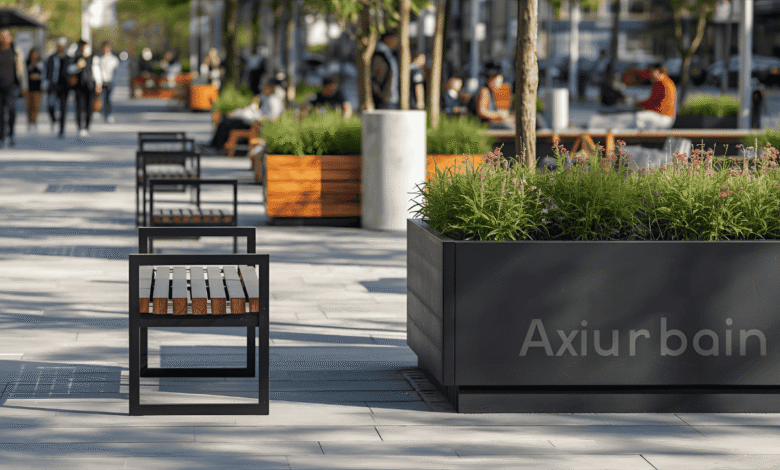Axurbain And The Evolution Of Urban Furniture Design In Modern Cities

1. Understanding Axurbain And Its Role In Urban Spaces
Axurbain was a French company that made a meaningful contribution to the design and production of urban furniture. Based in Fabrègues, a town in southern France, Axurbain specialized in creating high-quality public space equipment such as benches, planters, bins, and playground structures. The company focused on combining durability, functionality, and design to improve how people interact with city environments.
The work of Axurbain represented a growing movement in Europe that aims to make cities more livable through thoughtful urban furniture. Every product from Axurbain was designed to serve both a functional and an aesthetic purpose. The company emphasized the use of strong materials like steel, wood, and concrete, ensuring that their designs could withstand harsh weather conditions while remaining visually appealing.
Even though Axurbain was a small business with only a few employees, its influence extended beyond its size. The firm provided essential solutions for municipalities, urban developers, and architects looking to enhance the comfort and accessibility of public spaces.
2. The Story Of Axurbain From Growth To Transformation
Axurbain started as a small-scale initiative focusing on locally made urban furniture. Over the years, it built a reputation for reliable craftsmanship and sustainable material use. The company’s mission was centered on improving urban quality of life through creative and durable infrastructure.
However, like many small enterprises in the design and manufacturing sector, Axurbain faced market challenges. The competition grew stronger as global companies began offering mass-produced furniture at lower prices. This shift in market dynamics made it difficult for Axurbain to compete while maintaining its high standards of quality and design.
Eventually, Axurbain underwent structural changes and was deregistered from France’s commercial registry. This status indicated that the company had officially closed or merged with another entity. Some reports suggest that its operations and expertise were integrated into Agora Mobilier Urbain, a larger urban furniture producer that continues similar work.
Despite its closure, the impact of Axurbain remains visible in many towns and cities that still use its furniture. The benches, planters, and street structures it created continue to support everyday urban life, standing as a reminder of the company’s dedication to design and durability.
3. What Made Axurbain Unique In The Industry
The approach that Axurbain took towards manufacturing urban furniture set it apart from many competitors. Rather than focusing solely on profit, the company prioritized long-lasting quality and sustainable materials. Below are some elements that made Axurbain’s work distinctive:
• Emphasis on human-centered design for comfort and accessibility
• Use of recyclable and durable materials like steel and treated wood
• Craftsmanship that balanced traditional techniques with modern innovation
• Aesthetic integration with surrounding architecture and landscapes
• Responsiveness to the needs of municipalities and community projects
By applying these principles, Axurbain positioned itself as a thoughtful brand that valued the relationship between people and their environment. Its designs encouraged interaction, relaxation, and community engagement in public spaces.
4. Lessons From Axurbain For Modern Urban Development
Axurbain’s journey holds valuable lessons for today’s city planners and designers. As urban areas continue to grow, the demand for functional and sustainable infrastructure becomes even more important. Public spaces depend on well-designed furniture that encourages social interaction and supports everyday life.
From the story of Axurbain, one can learn that:
• Small-scale craftsmanship can contribute significantly to urban well-being.
• Sustainability should remain at the heart of design decisions.
• Municipalities must balance affordability with quality when selecting suppliers.
• Collaboration between designers and local governments can lead to long-lasting results.
The work of Axurbain reflected an understanding that public furniture is not just a utility—it is part of the social and cultural fabric of a city. A bench is not just a place to sit; it is a place to rest, meet people, or observe the rhythm of daily life. Axurbain’s commitment to these values continues to inspire discussions about how urban spaces should be built.
5. The Challenges Faced By Small Urban Furniture Makers Like Axurbain
Operating in the urban furniture sector presents a set of challenges that companies like Axurbain had to navigate carefully. One of the biggest obstacles was competition from larger firms that could produce at scale and sell at lower costs. Additionally, urban projects often involve complex bidding processes and regulatory standards that small companies find difficult to meet.
Another challenge was adapting to new design trends and sustainability expectations. Modern cities are increasingly demanding eco-friendly materials and smart technology integration, such as solar-powered benches and connected waste bins. For small manufacturers like Axurbain, staying up to date with these changes required continuous investment in research and innovation, which could strain limited financial resources.
Despite these difficulties, Axurbain managed to maintain a loyal client base and build trust through the quality of its work. Its story highlights the resilience and creativity that small enterprises bring to the world of urban design.
6. The Continuing Legacy Of Axurbain In Urban Design
Although Axurbain is no longer active as a company, its influence can still be felt in the industry. Many of its design philosophies live on through other urban furniture brands and city projects. The company’s focus on harmony between durability and aesthetics remains an essential reference point for urban designers.
Axurbain also left behind a model for how to integrate craftsmanship into modern city development. Rather than relying solely on mass production, its approach demonstrated that local design and manual expertise could play a vital role in shaping public spaces that feel welcoming and personal.
Cities across Europe continue to evolve, but the lessons from Axurbain’s work remind us that true urban beauty comes from thoughtful design and sustainable materials. By applying these principles, modern manufacturers and city planners can continue the mission that Axurbain once started.
7. Future Trends In Urban Furniture After Axurbain
The field of urban furniture is rapidly evolving, and many of the innovations align with the values once promoted by Axurbain. The new generation of designs is focusing on adaptability, sustainability, and technology. Some of the most significant trends include:
• Modular furniture that can be reconfigured easily for different uses
• Smart benches equipped with charging ports or solar lighting
• Environmentally friendly materials such as recycled plastic and bamboo
• Green urban furniture that integrates plants or living walls
• Digital tools that track maintenance and usage data
These innovations reflect a future where urban furniture serves as both a functional and intelligent part of the city. While Axurbain may no longer exist as a company, its philosophy continues to influence how designers approach these new developments.
8. Conclusion
Axurbain played a meaningful role in shaping the modern understanding of urban furniture. Through dedication to craftsmanship, material quality, and community-centered design, it showed how even a small company can make a lasting difference in public spaces. Although Axurbain has since closed, its legacy remains visible in the way cities continue to value thoughtful design and sustainable production.
The story of Axurbain is a reminder that urban development is not only about constructing buildings or roads but also about creating comfortable, functional, and beautiful environments for people. Its contribution continues to inspire architects, designers, and city planners who seek to build spaces that connect communities and reflect the human spirit of design.



